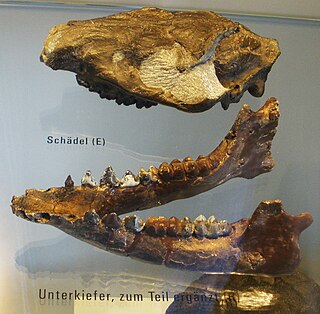
Hippopotamuses are stout, naked-skinned, and semiaquatic artiodactyl mammals, possessing three-chambered stomachs and walking on four toes on each foot. While they resemble pigs physiologically, their closest living relatives are the cetaceans. Hippopotamuses are the only living members of the family Hippopotamidae.

A pika is a small, mountain-dwelling mammal found in Asia and North America. With short limbs, very round body, an even coat of fur, and no external tail, they resemble their close relative, the rabbit, but with short, rounded ears. The large-eared pika of the Himalayas and nearby mountains is found at heights of more than 6,000 m (20,000 ft), among the highest of any mammal.

The Anatidae are the biological family of water birds that includes ducks, geese, and swans. The family has a cosmopolitan distribution, occurring on all the world's continents except Antarctica. These birds are adapted for swimming, floating on the water surface, and in some cases diving in at least shallow water. The family contains around 174 species in 43 genera.

Gannets are seabirds comprising the genus Morus, in the family Sulidae, closely related to boobies. "Gannet" is derived from Old English ganot, ultimately from the same Old Germanic root as "gander". Morus is derived from Ancient Greek moros, "foolish", due to the lack of fear shown by breeding gannets and boobies, allowing them to be easily killed.

Larus is a large genus of gulls with worldwide distribution. The genus name is from Ancient Greek laros (λάῥος) or Latin larus, which appears to have referred to a gull or other large seabird.

Anas is a genus of dabbling ducks. It includes the pintails, most teals, and the mallard and its close relatives. It formerly included additional species but following the publication of a molecular phylogenetic study in 2009 the genus was split into four separate genera. The genus now contains 31 living species. The name Anas is the Latin for "duck".

Struthio is a genus of birds in the order Struthioniformes, whose members are the ostriches. It is part of the infra-class Palaeognathae, a diverse group of flightless birds also known as ratites that includes the emus, rheas, and kiwis. There are two living species of ostrich, the common ostrich and the Somali ostrich. They are large flightless birds of Africa who lay the largest eggs of any living land animal. With the ability to run at 70 km/h (43.5 mph), they are the fastest birds on land. It is farmed worldwide, particularly for its feathers as they are used as decoration and feather dusters. Its skin is also used for leather products.

Eutamias is a genus of chipmunks within the tribe Marmotini of the squirrel family. It includes a single living species, the Siberian chipmunk. The genus is often treated as a subgenus of Tamias, which is now restricted to the eastern chipmunk of North America. Neotamias, which now includes the western North American chipmunks, has also been included in Eutamias.

Hystrix is a genus of porcupines containing most of the Old World porcupines. Fossils belonging to the genus date back to the late Miocene of Africa.

Leptoptilos is a genus of very large tropical storks, also known as the adjutant bird. The name means thin (lepto) feather (ptilos). Two species are resident breeders in southern Asia, and the marabou stork is found in Sub-Saharan Africa.

Agriotherium is an extinct genus of bears whose fossils are found in Miocene through Pleistocene-aged strata of North America, Europe, Africa, and Asia. This long-lived genus persisted from at least ~11.6–2.5 Mya. Materials from the late-surviving A. africanum in Africa have suggested that A. africanum died out during the early Gelasian.

Meleagridini is a North American tribe of birds in the subfamily Phasianinae. It includes turkeys and their extinct relatives.
Nestoritherium is an extinct genus of chalicothere; it has been dated to have lived from the late Miocene to the Early Pleistocene. This range makes Nestoritherium the most recently dated chalicothere to date. It has been found in fossil sites in Myanmar and China.

Khoratpithecus is an extinct genus of pongin primates that lived during the late Miocene in Myanmar and Thailand.
Brontochelys is an extinct genus of podocnemidid from the Miocene of Pakistan. The only species known, B. gaffneyi was classified before in the genus Shweboemys, which is known from the Pliocene of Burma. Brontochelys is represented only by its type specimen BMNH R.8570, a nearly complete skull, which exact locality is unknown but probably comes from the Lower Miocene sediments in the Bugti Hills, in Baluchistan, Pakistan. This skull is different from its relatives like Shweboemys, Lemurchelys and Stereogenys by its large, forward-faced orbits, a large frontal bone that composes most of the dorsal orbit margin and a palatal curved. The name of Brontochelys is formed by the Greek words bronte, "thunder" and chelys, "turtle", in reference to the large size of the skull.
This article records new taxa of fossil mammals of every kind that have been described during the year 2011, as well as other significant discoveries and events related to paleontology of mammals that occurred in the year 2011.
Glyphis pagoda is an extinct river shark from the Miocene.

Microbunodon was a genus of extinct artiodactyl mammals in the family Anthracotheriidae. It lived between the upper Eocene and the lower Pliocene. Its fossil remains have been found in Europe and Asia.
Hystrix primigenia is an extinct species of Old World porcupine that lived during the Late Miocene and Pliocene. Fossils of this species were recovered mainly from southern Europe, from Spain to Turkey and North Africa as well. The earliest fossils were found in Greece and the Balkan peninsula.













